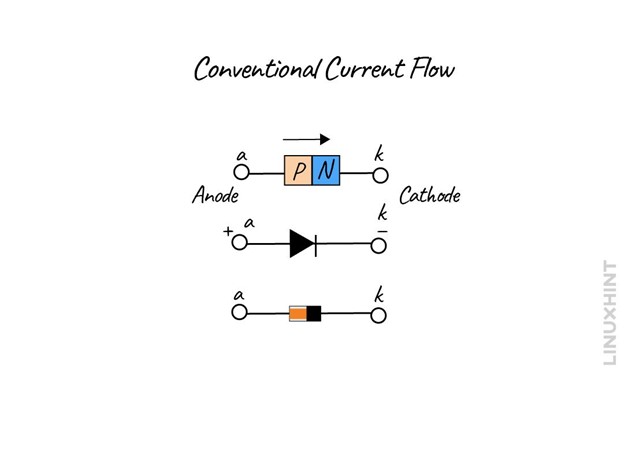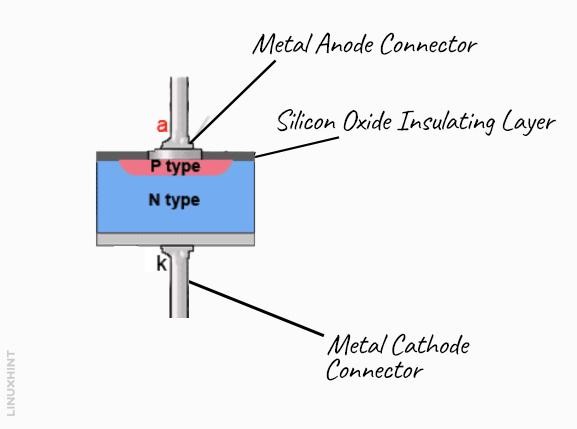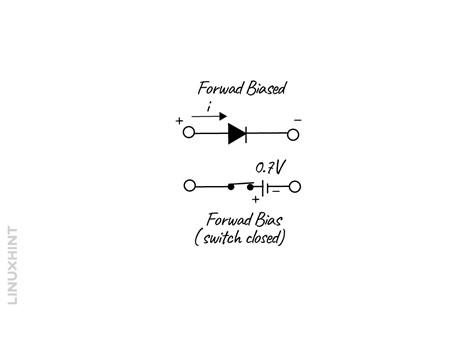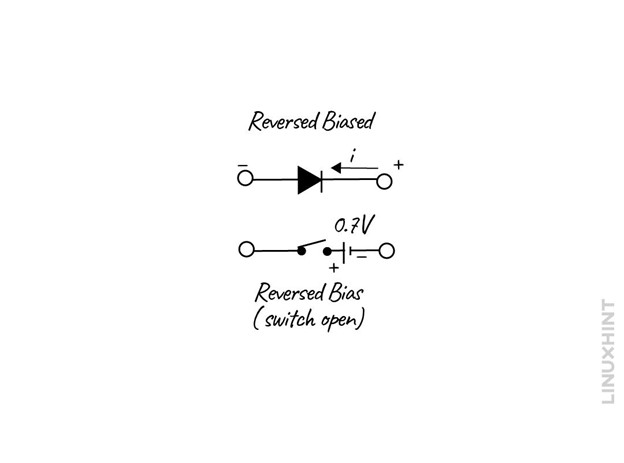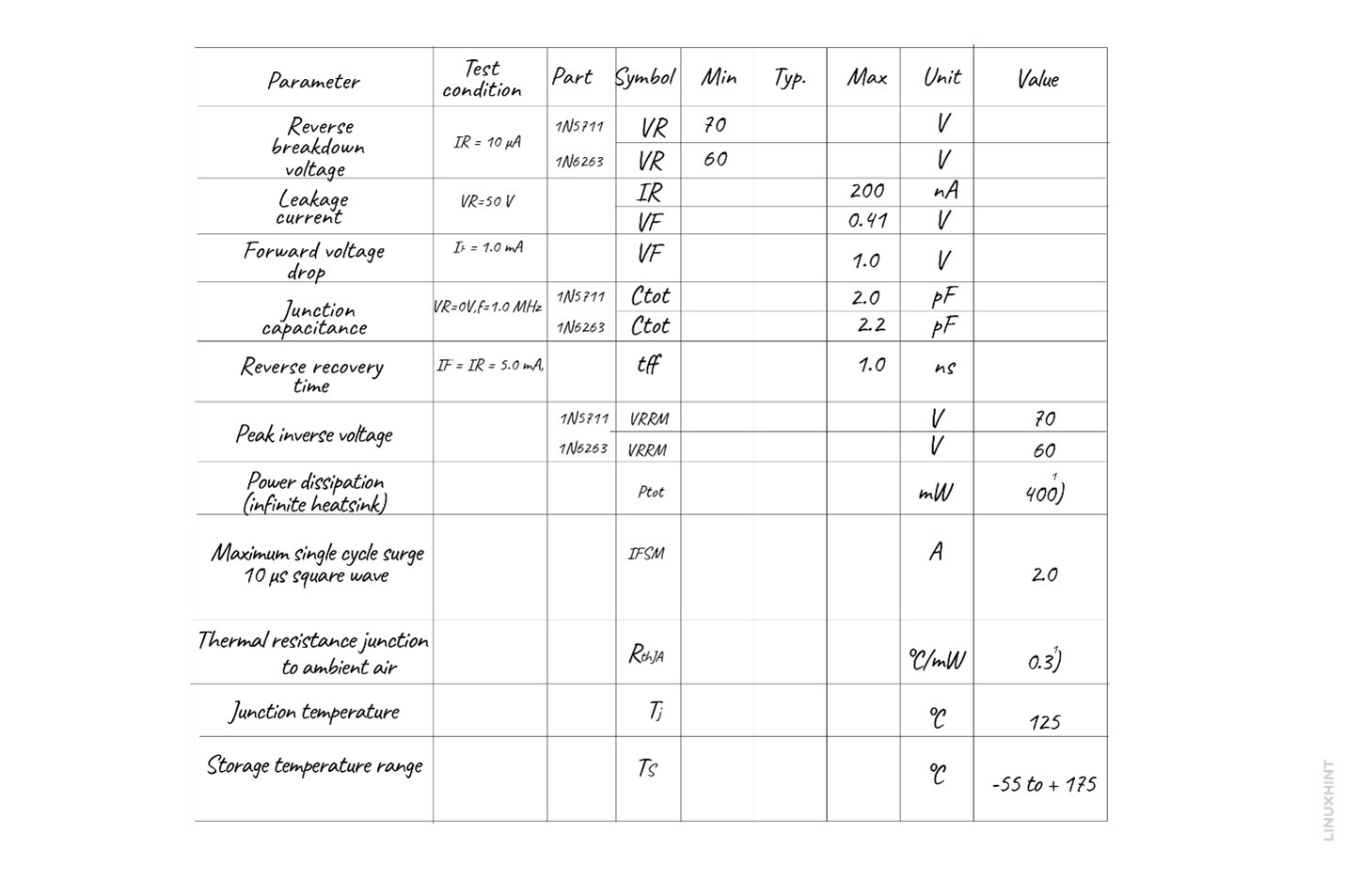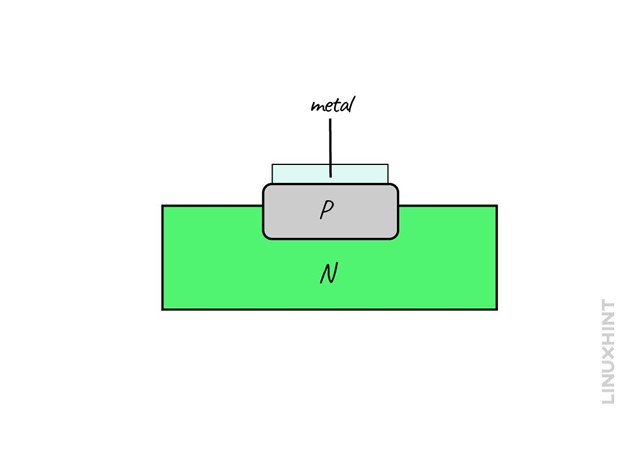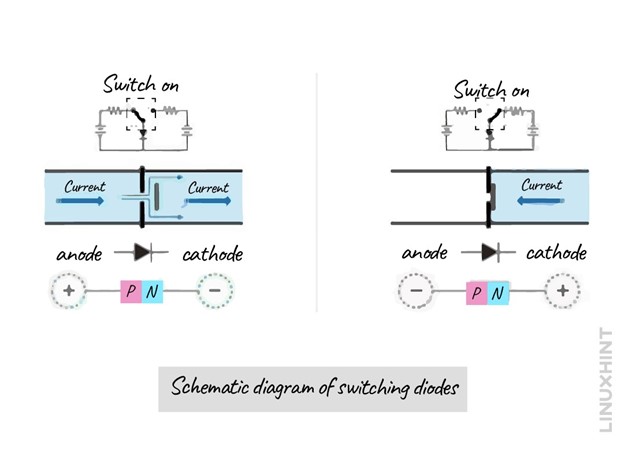Outline:
- What is a Signal Diode
- VI characteristics of Signal Diode
- Signal Diode Parameters
- What is a Switching Diode
- Conclusion
What is a Signal Diode?
A signal diode is a small PN junction semiconductor that is covered in glass material, has a red or black band on the cathode terminal. This diode has a current capability of up to 100 milliamps and is preferred to be used in circuits due to its lower resistance. The signal diodes work best in electrical circuits that involve short-duration pulse switching or clipping applications. The signal diode is also called as a point diode because of its small size, below is the symbol of the signal diode:
Construction and Working of Signal Diode
Like other diodes, the signal diodes are also made up of P-type and N-type materials having a small junction area. Due to the small junction area, the diode has lower capacitance, and it also decreases the recovery duration slightly up to a few microseconds. As a result, this low capacitance and rapid response due to low recovery time makes the point diodes suitable for high-frequency applications. A simple signal diode is made by infusing the P-type silicon or germanium material with N-type silicon or germanium material as shown below:
To give a much better concept for the construction of a signal diode, it won’t be wrong to say that a signal diode has a similar construction design as that of a mesa diode. The mesa diode has some part of the PN junction carved with acid, giving it a plateau structure. Here the N-type region is further segregated into two parts, one is close to the P-type material that is lightly doped, and the other is with the material that is highly doped near the negative terminal. This type of construction in the signal diode is mostly preferred to get better predictions on its parameters. Apart from that, this type of construction makes it more reliable, and to protect the diode from oxidation generally a layer of silicon oxide or a passivated glass is used.
Types of Signal Diode
Like other diodes, the signal diodes are also composed of either silicon or Germanium and due to different compositions, there are differences in the specifications of signal diodes. The point diode has a power rating of around 500 milliwatts, which is quite low compared to the other rectifier diodes.
Silicon Signal Diodes
These signal diodes have a voltage drop of 0.6 to 0.7 around the PN junction, and they have quite high reverse resistance. However, they have low forward resistance due to which they have high peak values for forward current and reverse voltage.
Germanium Signal Diodes
Unlike the silicon point diodes, these have a voltage drop of 0.2 to 0.3 around the PN junction due to the lower reverse bias resistance. However, they have high forward resistance due to the smaller junction area.
VI characteristics of Signal Diode
There are two biasing configurations of signal diodes just like other conventional diodes, that is, one is forward bias and the other is reverse bias. In both configurations, the diode acts differently and below is the characteristic curve of voltage and current of signal diode:
Forward Bias Configuration
When the anode is connected to the positive terminal of the supply and the cathode is connected to the negative terminal of the source, it is said to be in forward bias condition. Moreover, in this configuration, the diode is short-circuited and will not allow the flow of current until the supply voltage exceeds the junction voltage. As mentioned above the junction voltage for silicon is 0.6 to 0.7 and for germanium, it is 0.2 to 0.3 so when this voltage level is breached the diode allows the flow of current. The flow of current increases with even a slight increase in the supply voltage.
Reverse Bias Configuration
When the cathode terminal of the signal diode is connected to the positive end of the source and the anode with the negative point of the supply, then this diode is said to be in reverse bias configuration. Moreover, in this configuration, the diode is open-circuited and there will be a small amount of current due to the minority charge carriers. The minority charge carries pass the depletion layer which causes the flow of current which is often known as leakage current. If the supply voltage exceeds to a higher value these minority carriers will break their covalent bonds and this state is known as a breakdown.
Breakdown Region
In the reverse bias configuration, the signal diode can limit the current until the voltage exceeds the voltage rating. If the voltage exceeds, then the diode gets damaged, however the flow of current in reverse bias is quite different as it is very low, and the direction is opposite. It is always advisable to connect the resistor will the diode in case the excess voltage cannot damage the diode.
Signal Diode Parameters
The signal diodes come with a wide range of voltage and current ratings but before selecting the specification of the signal diode one must know some of the important parameters that affect its working. These parameters play an important role in selecting the suitable signal diode as the specification of point diodes vary with them:
- Maximum Forward Current
- Maximum Reverse Voltage
- Total Power Dissipation
- Forward Recovery Voltage
- Maximum Operating Temperature
- Reverse Recovery Time
- Forward Voltage
- Diode Capacitance
- Reverse Current
Maximum Forward Current
In the forward bias condition, the signal diode has quite low resistance across its PN junction, and the power is dissipated from the PN junction in the form of heat. So, if the current increases, then the heat will also increase, and if the increase is continuous then the diode will fail due to thermal overload. So, the maximum forward current is the value that the signal diode can easily bear, or in other is the safe current limit for the diode. Also, it is a safe practice to use a resistor with the diode to limit the forward current, and proper ventilation should be provided for the dissipation of heat.
Maximum Reverse Voltage
When the diode is in reverse bias it blocks the flow of current, but still, there is a leakage current due to minority charge carries. In reverse bias, there is a safe limit for the voltage till which the diode can hold the current from not flowing into the circuit, often named peak inverse voltage or maximum reverse voltage. The voltage rating is slightly less than the breakdown voltage and ranges up to a thousand volts, so while looking at the specifications of the signal diode this parameter should be considered. The peak reverse voltage for both the AC and DC circuits is the same for signal diodes.
Total Power Dissipation
In forward bias condition, the PN junction offers some resistance and as a result, some power is dissipated in the form of heat. The signal diode has a rating for power dissipation, which can be calculated by finding the product of the voltage drop and current. This rating is usually in milliwatts.
Forward Recovery Voltage
To switch the signal diode to forward current, a certain voltage is required, which is often named as the forward recovery voltage. This is an important parameter to consider if the diode is to be used in any application or circuit that requires rapid switching and is usually greater than the normal forward voltage.
Maximum Operating Temperature
The operating temperature of the signal diode is affected by the junction temperature that might arise due to an increase in power dissipation and the surrounding temperature as well. So, if the operating temperature exceeds the given safe limit then it might damage the diode thus affecting its functionality. Moreover, the lower the temperature, the better will be the efficiency of the diode.
Reverse Recovery Time
If the diode is to be used in an application or circuit that requires rapid switching, then this is the most important factor that is to be considered. This is the time that the diode takes to switch back to the forward bias configuration, and it is usually in nanoseconds.
Forward Voltage
The forward voltage is the minimum voltage threshold that is to be breached to allow the flow of current through the signal diode. This mainly depends on the material composition of the diode, as mentioned above for silicon it is around 0.8, and for germanium, it is around 0.3 volts.
Diode Capacitance
The diode typically has two types of capacitances, one is junction capacitance which is due to the depletion region and is in both the bias configuration of the diode. Mostly on the junction capacitance is taken into consideration as it is affected by the depletion region. This parameter is usually important if the diodes are to be used on oscillator circuits.
Reverse Current
In the reverse bias, there is a leakage current due to the minority carriers, and this current is normally referred to as the reverse current. The reverse current mainly depends on three factors: reverse voltage, temperature, and the material of the semiconductor. The reverse voltage is the most significant, as the major portion of the reverse current depends on it.
Further, here is the specification for the signal diode having the serial model 1N5711:
What is a Switching Diode
The diodes that are specifically used for performing a switch function of turning on and off in any circuit or application are known as switching devices. The switching might include turning on or off any device, or it could be switching off the device to any other network. These diodes work in the same way as the typical diode, that is they will allow the flow of current when the voltage exceeds the threshold point.
Working of Switching Diode
Connecting the diode with the supply in forward bias is just like turning on any switch, as the switch is closed the current will start to flow. Once the switch is turned off, that is the diode is in reverse bias the flow of current will be stopped. Diodes in the forward bias have the least resistance, and in the reverse bias, it is quite the opposite.
For switching diodes, the capacitance barrier has quite low impedance under high frequencies, and if the capacitance reaches a certain value, then it might affect the diode performance. To maintain and achieve the unidirectional flow of current at higher frequencies, the barrier capacitance is kept relatively small in switching diodes.
Switching Diode Characteristics
The switching diode is quite small and has a considerably high switching speed, high reliability, and longer life. When the switching diode poles are connected with the forward voltage, it goes to its on state. The time taken by the switching diode from switching off the high resistance state to the low resistance state that is conducting state is it turning on time.
The time taken from turning on to the fully functioning state is the recovery time, and the sum of the recovery time and turn-on time is the switching time. Normally the recovery time is higher than the turning-on time, so on the switching diode specifications, it is stated under parameters for operation.
The switching diodes have quite high switching speeds, lower junction capacitance and small internal resistance when in the conduction state. The switching diodes can also be said to be signal diodes, as there are some similarities in their functionalities and have similar parameters for specifications.
Conclusion
Diodes are generally used for a wide range of applications and are based on the application they are divided into various types. The signal diodes and switching diodes are mainly used in high-frequency applications, clipping applications, and circuits that are involved in dealing with short-waveform pulses. The signal diode conducts when the forward voltage is applied and blocks the flow of current in the reverse bias configuration.

